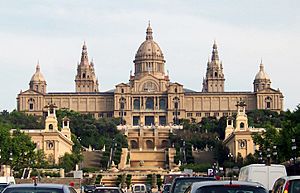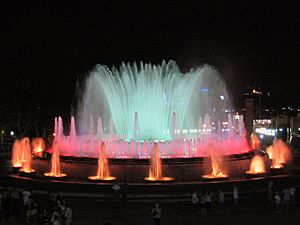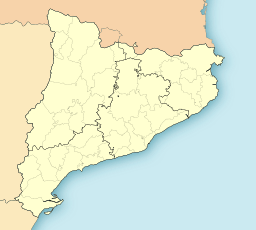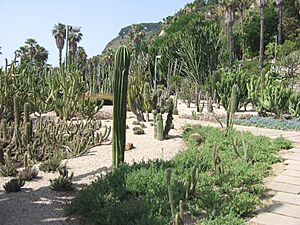Montjuïc facts for kids
Quick facts for kids Montjuïc |
|
|---|---|
 |
|
| Highest point | |
| Geography | |
Montjuïc (Catalan pronunciation: [muɲʒuˈik]) is a famous hill in Barcelona, Catalonia, Spain. It's a broad, low hill with a flat top that looks over the city's harbor. Montjuïc has a very long and interesting history. It was even the starting point for the city of Barcelona itself!
Because of its great location near the Mediterranean Sea and the Llobregat River, Montjuïc has always been important. Over the years, it has been home to old forts, big events, and beautiful gardens. For example, the 1929 International Exposition was held here, and later, many events for the 1992 Summer Olympics took place on the hill. Today, you can visit museums, parks, and enjoy amazing views from Montjuïc. You can get there easily using a funicular railway or a cable car.
Contents
What's in a Name?
The name Montjuïc means "Jewish Mountain." It comes from old Latin and Catalan words. This name likely came about because a medieval Jewish cemetery was found on the hill. Some people also think the name might come from the Latin phrase Mons Jovicus, which means 'hill of Jove' (a Roman god). There's another hill with the same name, Montjuïc, near the city of Girona, which also had a medieval Jewish cemetery.
Montjuïc Through History
Montjuïc's location was perfect for a city to grow. It was right by the Mediterranean Sea and a major river, the Llobregat River. This is why Barcelona started here! In ancient times, especially during the Roman period, Montjuïc was a big quarry. This means people dug out a lot of stone from the hill, which changed its shape quite a bit.
In 2007, a special part of Montjuïc was declared a "Cultural Asset of National Interest." This was because of the medieval Jewish cemetery found there. It is thought to be the largest of its kind in Europe from that time.
The top of Montjuïc, which is about 185 meters (607 feet) high, has always been a good spot for defenses. The Castle of Montjuïc stands there today. This fortress was mostly built in the 1600s, with more parts added in the 1700s.
The castle was used as a prison for a long time, often holding people who were against the government. It was also a place where many people were executed. During difficult times, like the Spanish Civil War, people from both sides were executed at the castle. A famous Catalan leader, Lluís Companys, was also executed there in 1940.
Big Changes and Events
Montjuïc was once covered in trees. People from the nearby old city used its slopes to grow food and keep animals. In the late 1800s, some of the forests were cleared to make space for parks.


The biggest changes started when Montjuïc was chosen to host the 1929 Barcelona International Exposition (a type of World's Fair). Many large buildings were constructed for this event. Some of these buildings are still standing today, like the impressive Palau Nacional, the Estadi Olímpic (Olympic stadium), and the amazing Magic Fountain of Montjuïc (Font Màgica). There's also a grand staircase that leads up from the bottom of the hill to the Palau Nacional.
Another interesting place built for the 1929 Exposition is the Poble Espanyol. This is a "Spanish village" with buildings made in different styles of Spanish architecture. It's located on the western side of the hill. The famous German national pavilion, designed by Mies van der Rohe, was also built at the foot of the hill. It was taken down in 1930 but rebuilt in 1988.
The Olympic stadium was finished in 1929. It was originally planned to host an alternative Olympics in 1936, but these plans were canceled because of the Spanish Civil War. The stadium later became the home for the football team RCD Espanyol until 2008.
The roads on the slopes of Montjuïc were once used as a Formula One race track, called the Montjuïc circuit. The Spanish Grand Prix was held here four times. However, a serious accident in the 1975 race caused the Spanish Grand Prix to never return to Montjuïc.
Montjuïc was chosen again for the 1992 Summer Olympics. The Olympic stadium was completely updated and became the main venue. It hosted the opening and closing ceremonies and the athletic events. Around the stadium, an "Olympic Ring" of sports venues was built. This included the Palau Sant Jordi indoor arena, the Piscines Bernat Picornell and the Piscina Municipal de Montjuïc (swimming and diving pools), and the striking Montjuïc Communications Tower, designed by architect Santiago Calatrava. The diving pool was even used for a music video by Australian singer Kylie Minogue in 2003!
Today, the beautiful Palau Nacional building is home to the Museu Nacional d'Art de Catalunya. This museum has a huge collection of Catalan paintings and sculptures.
You can easily reach the top of Montjuïc using the Funicular de Montjuïc, which is part of the Barcelona Metro system. From there, you can take the Montjuïc Cable Car, a gondola lift, to the very top. On the eastern side of the hill, you can also find the Miramar station for the Port Vell Aerial Tramway. This cable car connects Montjuïc to Barceloneta across the Port Vell harbor. Many parts of the hill are covered with lovely parks and gardens, which are popular places for people to visit and enjoy. The hill is also often used for cycling.
Other Places to See on Montjuïc
- Fundació Joan Miró: This is a modern art museum that has a large collection of works by the famous artist Joan Miró.
- Montjuïc Cemetery (Cementiri del Sud-Oest): This cemetery is the final resting place for many important people, including former Presidents of Catalonia, Lluís Companys and Francesc Macià. The artist Joan Miró, dancer Carmen Amaya, and poet Jacint Verdaguer are also buried here.
- The botanical gardens: These gardens are home to many different types of plants.
- The museum of ethnology: This museum explores human cultures and societies.
- The Catalan museum of archaeology: This museum is housed in a building from the 1929 exhibition and displays ancient artifacts.
- The Olympic and Sports Museum Joan Antoni Samaranch: This museum celebrates the history of the Olympics and sports.
Images for kids
-
View of Montjuïc (Barcelona) from Park Güell
See also
 In Spanish: Montjuic (Barcelona) para niños
In Spanish: Montjuic (Barcelona) para niños
- Public art in Barcelona
- History of Barcelona
- The Four Columns
- Siege of Barcelona (1713–1714)
- Urban planning of Barcelona







